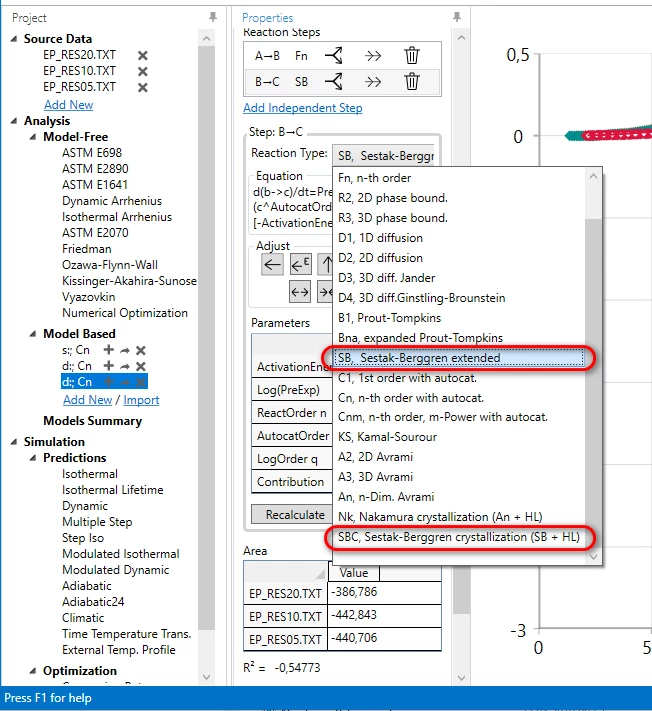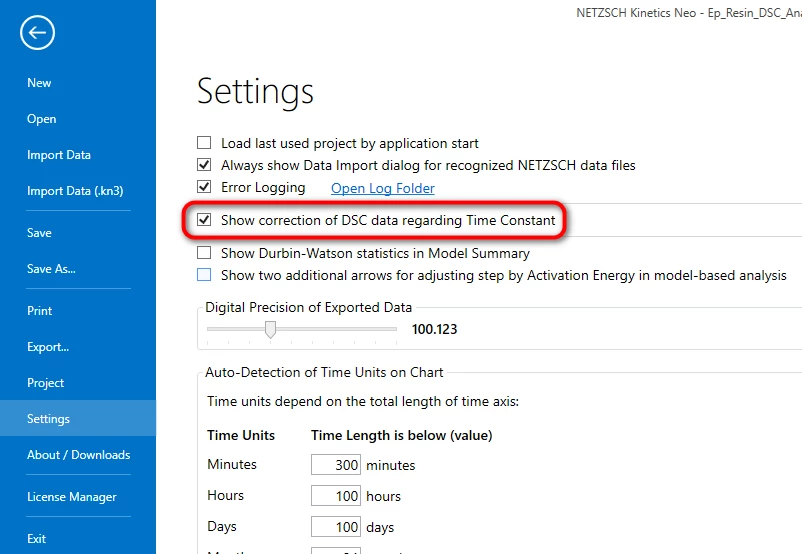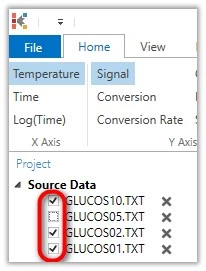What is new in Kinetics Neo version 2.6.0
Two New Reaction Types for Crystallization in Model-Based Analysis
SB (Sestak-Berggren, chemical reaction with crystal building) and SBC (polymer crystallization from the melt, since version 2.6.1 "SbC – Sbirrazzuoli Crystallization")

Sestak-Berggren Extended, Chemical Reaction with Crystal Building
Up to now we had Reaction typesReaction type is the elementary mechanism of one individual reaction step in multi-step chemical reaction. Reaction type f(Cr, Cp) describes dependence of the reaction rate for individual reaction step on the concentrations of reactant Cr and product Cp for this step.reaction types for acceleration either for autocatalysis (Bna, C1, Cn, Cmn, Kamal-Sourour) or for nucleation (A2, A3, An). However, our customer often ask for more common model containing both acceleration types together in one reaction type. This is reaction type according to Sestak-Berggren equation. Now we have implemented this new reaction type.
SBC: Polymer Crystallization from the Melt (since version 2.6.1 "SbC – Sbirrazzuoli Crystallization")
Up to now we had crystallization types according to Avrami nucleation (reaction types A2, A3, An). Crystallization According to NakamuraCrystallization according to Nakamura is the crystal growth model for non-isothermal crystallization kinetics during cooling.Nakamura crystallization uses Avrami nucleation too. However, many of our experimental cooling measurements cannot be described by one-step Avrami type or by one-step Nakamura crystallization type. The new model suggested by Sbirrazzuoli and coauthors is more general type and it can well describe most experimental crystallization data as one-step process and non-arrhenian rate dependence.
Reference: Nathanael Guigo, Jesper van Berkel, Ed de Jong , Nicolas Sbirrazzuoli, Modelling the non-isothermal crystallization of polymers: Application to poly(ethylene 2,5-furandicarboxylate), Thermochimica Acta 650 (2017) 66-75 https://doi.org/10.1016/j.tca.2017.02.008
DSC Deconvolution (“DSC Correction”, "DSC Desmearing")
Some of our Kinetics customers work with heavy crucibles (like high-pressure crucibles, medium pressure crucibles) or with high temperatures instruments with heavy system having long time constants. This means the instrument distorts the measured information about test substance. Because of this, the DSC signal in such conditions must be corrected to remove influence of the long time constants on measured signal.
In the standard NETZSCH software, Tau-R option has this functionality. We recommend to continue use it.
Some of Kinetics Neo customers have non-NETZSCH instruments. They also would like to remove the influence of the time constants from DSC signal.
We have developed and implemented in Kinetics Neo new deconvolution procedure (DSC correction regarding time constant). This method is completely new and has better mathematics than in Tau-R.
To use the DSC Deconvolution feature you must switch the option "Show correction of DSC data regarding Time Constant" in File / Settings:

After that DSC Deconvolution in can be used in section Time Constant Correction of Data Preparation panel:

Source Data Files May Be Switched On (Enabled) or Off (Disabled)
Source measurement files may be switched On (enabled) or Off (disabled) in Kinetics Neo project. All source files, even disabled, remains loaded in the project. The model-free and model-based analysis is based only on enabled source files.

After switching the source data file ON or Off the model-based analysis will be NOT optimized automatically. This is done so because if Kinetics Neo project contains many models then this automatical optimization step could take time. That's why after switching the data source enable state ON / OFF, the model-based analysis will contain the same analysis parameters like Activation Energy Log(PreExp) etc as before.
We definitely recommend you to optimize the model-based analysis manually for these models which are important for you after changing the enable state of the data source files.
Other Improvements and Bug Fixes
Improved: literature references in the description of model free method (Friedman, Ozawa-Flynn-Wall, ...).
Fixed: exporting equation for ARC and DEA (sign for total effect). Calculations were correct and have no changes.
Fixed: scale of the first visualization of conversion rate during copy of model (for both original and copied model). Calculations were correct and have no changes.
Fixed: selected range in source data files stays constant now for multiple changes between source data curves.
Fixed: exporting equation for ARC and DEA (sign for total effect).
Fixed: scale of conversion rate during copy of model (for both original and copied model).
Other small improvements and bug fixes.
